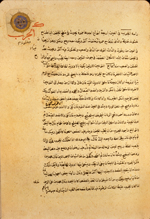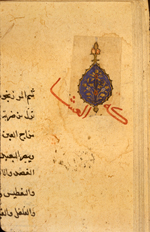Catalogue: Medical Encyclopedias
Encyclopedias
-
 Kitāb al-Ghiná wa-al-muná
(MS A 11)
Kitāb al-Ghiná wa-al-muná
(MS A 11) - (The Book of Wealth and Wishes)
- كتاب الغنى والمنى
- by Abu Manṣūr al-Ḥasan ibn Nūḥ al-Qumrī (d. shortly after 990/380 H)
- ابو منصور الحسن ابن نوح القمرى
Abu Manṣūr al-Ḥasan ibn Nūḥ al-Qumrī was the teacher of Ibn Sīnā [Avicenna]. He dedicated his only treatise to the Samanid prince al-Manṣūr, for whom he was court physician. Because of this dedicatee, the treatise was sometimes known as al-Shamsiyah al-Mansuriyah (The Mansurian Sunshade), in addition to its more usual title Kitāb al-Ghiná wa-al-muná. The latter title can be translated loosely as The Book of Wealth and Wishes. For a discussion of this treatise and the difficulties of translating its title, see Ghada Karmi, "Arabic medicine in the 10th century: A study based on the book Ghina; wa Muna by Abū Manṣūr al-Hasan b. Nuh al-Qumri", in Proceedings of the First International Symposium for the History of Arabic Science, April 5-12, 1976, Vol. II: Papers in European Languages (Aleppo, Syria: Institute for the History of Arabic Science, 1978), p. 326-335.
The treatise is a general medical encyclopaedia reflecting everyday practice, with great interest shown in drug therapy. It consists of three sections (maqalahs): The first is concerned with diseases occuring in specific organs, discussed head to foot. The second is on external and superficial diseases not restricted to only one part of the body, and the third on fevers.
For other copies, see Ullmann, Medizin, p. 147; Iskandar, "UCLA", p. 38; and Savage-Smith, "Bodleian", MS Marsh 80.
Kitāb al-Ghiná wa-al-muná (MS A 11)
Illustrations
Sample page concerned with the treatment of trachoma (jarab in Arabic), from the treatise Kitāb al-Ghiná wa-al-muná by al-Qumrī (d. shortly after 990/380). Ornamental medallions from another, older, manuscript have been cut out and pasted into the margins.
Detail of one of the ornamental medallions that have been cut out of an earlier (possibly Timurid) manuscript and pasted into the margins of this copy of Kitāb al-Ghiná wa-al-muná by al-Qumrī (d. shortly after 990/380).
Physical Description
Arabic. 199 leaves. Dimensions 18.2 x 12 cm; text area of fols. 1-14a is 14.4 x 7 cm; text area of fols. 14b-199 is 13 x 6.8 cm; 20 lines per page through fol. 14a; 21 lines per page thereafter. The title is given at the end of the first and second chapters (fols. 140a and 164a). In the colophon on fol. 199b, only Abū Manṣūr from the author's name can be read (in line 8); the rest of the colophon has been damaged and partially torn off. The full name of the author is taken from other copies and secondary sources.
This copy is missing the start of the treatise, and begins with the section on headaches. The final folio is badly damaged, so that the colophon is nearly obliterated.
The copy is undated and unsigned. The general appearance of the paper, ink, and script suggest a dating of the 17th century. It must have been completed prior to 1704, when a note was added on fol. 199b stating that in the month of Jumadá I, 1116, [September 1704] Muḥammad Hādī al-Shīrāzī collated the manuscript from start to finish and noted most of the mistakes and made emendations.
The text was copied in two distinct hands. Fols. 1-14a are written in a medium-small, careless nasta‘liq, while fols. 14b-199 are in a small, very neat and elegant naskh script. Black ink with headings in red, as well as red and black overlinings. In the second hand there are fewer red overlinings and headings. There are also red marginal headings. On fol. 133a there is a note quoting a doctor (al-hakim) al-Fadil Kushyar. There are numerous marginal corrections and glosses, some quite extensive, and many collation notes. A more recent hand has entered recipes in some of the margins.
Throughout the manuscript, carefully executed ornamental medallions have been cut from another manuscript (possibly a late Timurid manuscript) and pasted into the margins. Examples are given in the illustrations of fol. 26a and 28b.
The glossy biscuit paper has evenly dispersed fibers with some inclusions and occasional thin patches. It has sagging horizontal laid lines, but no chain lines. There is some water damage to the paper, and repairs have been made to some folios. Fol. 1 is guarded. The edges have been trimmed from their original size.
Binding
The volume is bound in a modern European library binding of maroon leather over pasteboards, with blind-tooled borders on the covers. There are black paper pastedowns and modern blank endpapers.
Provenance
On fol. 199b there is a note stating that in the month of Jumadá I, 1116, [September 1704] Muḥammad Hādī al-Shīrāzī collated the manuscript from start to finish and noted most of the mistakes and made emendations. Also on fol. 199b is an undated owner's stamp with the name ‘Abd Allāḥ Faḍl.
The volume was purchased in 1941 by the Army Medical Library, apparently from A.S. Yahuda, though the volume lacks the usual ELS numbered annotations usually found in volumes belonging to Yahuda.
References
Schullian/Sommer, Cat. of incun. & MSS., entry A11, p. 300.
NLM Microfilm Reel: FILM 48-114 no. 1












